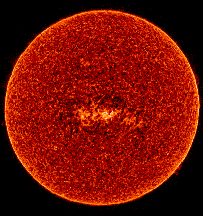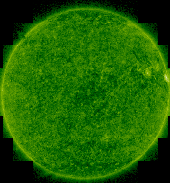|
|
|
Other RHESSI |
|
|
|
|
|
|
|
|
|
|
|
|
Shorter Wavelengths of Light:
Ultraviolet (UV)
This is how the Sun looks in ultraviolet light when given a false color. The picture on the left uses longer UV wavelengths, and the picture on the right uses shorter UV wavelengths. Notice how the surface structure details on the Sun change as the imaging wavelengths get shorter.
Pictures are courtesy of SOHO/SUMER consortium. SOHO is a project of international cooperation between ESA and NASA.
Beyond the shortest wavelength of light that we can see are even shorter waves called ultraviolet or UV light. These wavelengths can not be seen by the human eye. Because shorter wavelengths of light have more energy and penetrate more than visible light, high energy UV rays can Sunburn skin tissue by bursting small blood vessels. DO NOT look directly at the Sun since the ultraviolet and infrared rays will damage your retina.
Because the skin makes a lousy imaging device and the human eye is not a UV detector, scientists have devised other means of imaging UV sources. One option is to use UV sensitive film with cameras or telescopes. Optical elements of these instruments such as mirrors or lenses must be able to focus the UV light without absorption before it reaches the film. Constructed with appropriate optics and sensors, video cameras can image UV sources. The atmosphere presents a problem if you are viewing a star from the Earth. The ozone layer in the upper atmosphere absorbs the UV energy so that we can escape its harmful effects. The atmosphere also puts wavy distortions in the images. Much better images can be made if the telescope can be placed above the atmosphere. To see UV light images of hot plasma in magnetic loops above the photosphere click here.
![]()
 left
left right
right
